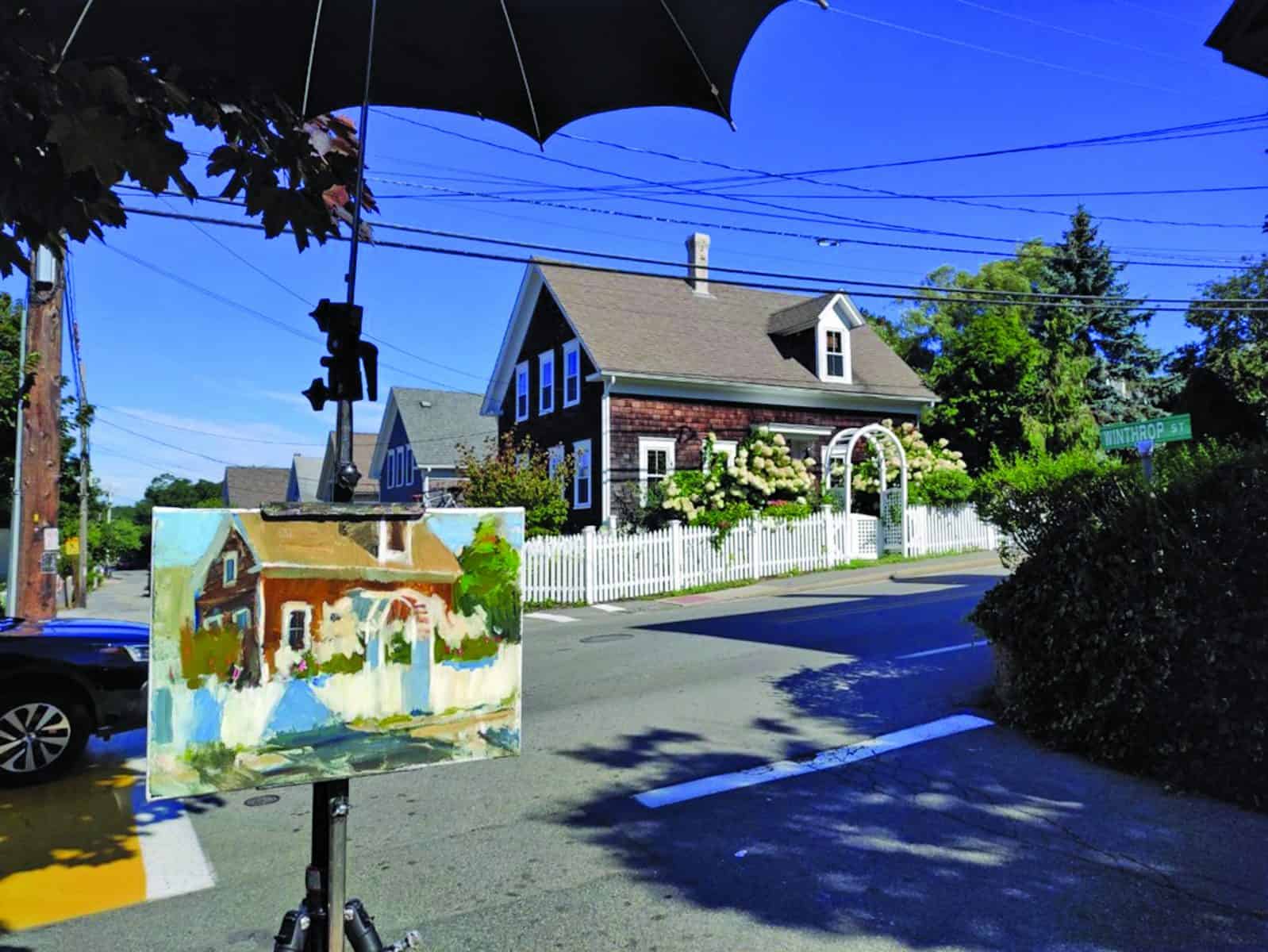Path to the Beach (oil on panel 11 x 14”). All images courtesy of Simie Maryles Gallery
by Lynn Stanley
In the book Art in Narrow Streets, the artist Ross Moffett describes Provincetown as a bucolic village filled with towering elm and poplar trees; an artist could buy a meal for twenty cents, and nary a nightclub or a bar could be found. This was the Provincetown of 1914, and painters had embraced working en plein air, attempting, as they set their easels in the sand or on the wharves, to capture light and color out-of-doors. The practice had overtaken earlier approaches to land and seascapes, when artists completed their work in controlled, studio environments.

All images courtesy of Simie Maryles Gallery
Moffett had traveled from the Midwest to study with Charles W. Hawthorne at his Cape Cod School of Art. Hawthorne had perfected the skill of “painting on the spot” with the artist William Merritt Chase, while attending his summer school in Southampton, N.Y. Students painted on the beaches and rolling dunes, watched demonstrations, and received weekly critiques of their work. In 1899, when Hawthorne settled in Provincetown to launch his own summer school, he followed Chase’s successful formula, and not only popularized the impressionist painting technique, but was instrumental in establishing the art colony that continues today.
A few things have changed in town over the past century, but the brilliant light, the vessels bobbing in the glittering harbor, and the love of art and artmaking remain. Over 40 galleries are in operation, including the Simie Maryles Gallery, celebrating its 25th season this year. Simie Maryles is herself a gifted artist, with decades of experience as a plein air painter; her gallery is a painter’s oasis, featuring jewel-like trompe l’oiel compositions, and incandescent still life studies.
She’s also expert at identifying and welcoming talent to town, which is how a young midwestern artist, Ken Cadwallader, found his way from Michigan 20 years ago. Maryles had seen his work in magazines, but nothing prepared her for the quality of his brilliant, expressive canvases. An avid traveler, Cadwallader has painted in China, Thailand, Brazil, and Costa Rica, and his virtuosity includes portraiture, still life, street scenes, and landscapes.
For the first time this summer, Cadwallader will devote two weeks to painting Provincetown. In a kind of artistic take on Where’s Waldo, Maryles is posting images on Facebook of the artist at work, leaving the viewer to sometimes guess his location. Images of the alla prima paintings are included. Cadwallader hopes to complete up to 20 works, if the weather cooperates.





All image scourtesy of Simie Maryles Gallery
When asked about his childhood, Cadwallader remembers watching his father draw, entranced as a few lines magically coalesced into an image. A quiet kid who preferred solitude to the activities available in his blue-collar town, he centered himself in artmaking. At a pivotal moment in high school, however, a careless teacher lost a portfolio of his artwork. Disillusioned, he struggled to find a clear path forward and looked for more conventional ways to make a living.
An encounter with an energetic art history teacher at a community college started to change things for him. More support came from an unlikely source while working a part-time night job. He’d started to make art again on the side, and his supervisor asked him to create a portrait. When a full-time position opened up, Cadwallader approached the manager with his best “I’m your guy” spiel, and was stopped in his tracks: “Ken, don’t do this. You have talent. Go pursue your art.”
Once he recommitted, the way started to become clear. He was able to study abroad at the Royal College of Art in London, and the revelation of seeing European masterpieces transformed his understanding of art. His encounter with the bold brushwork and naturalistic color in John William Waterhouse’s massive Pre-Raphaelite composition, The Lady of Shalott, helped hone his aspirations. He continued to study and credits the alla prima painter Richard Schmid with helping him over the final hurdle of transmuting colors found in nature onto a picture plane.
He went on to join the Oil Painters of America and served as its president from 2014-16. It was there he met the gifted, unassuming Chinese painter Zhiwei Tu, who invited Cadwallader to accompany him and a group of OPA artists to China to paint and exhibit.
“What he neglected to tell us was that in China, Zhiwei Tu is an art star and a major celebrity. When we arrived, we were greeted by dignitaries and young girls holding flowers. It was incredible,” Cadwallader says. The artist was transformed by his experience in China, and returns there regularly to live and paint.
Today, Cadwallader’s masterful use of color and energetic brushwork are evidenced in everything he creates. He loves the narrow, winding streets of Provincetown, where compositions present themselves at every turn. Passersby often approach him and say “I want to learn to paint like this,” or “I used to paint, and wish I could start again.” The artist’s advice? “Don’t wait-just go do it.” He laughs and says that perseverance trumps talent. “Your first twenty minutes are going to be the worst ever. Your canvas may blow over, or you’ll spill something, or you’ll struggle to get anything down, but keep going! It gets better and you’ll start to enjoy it, I swear! Paint every day,” he says.
Cadwallader is also a gifted teacher, another skill he shares with the generous artists who paved the way in this once remote, seaside village. He hopes his efforts will help inspire the next generation of painters, a sentiment that—like the artist himself—is pure Provincetown.
Ken Cadwallader’s new Provincetown paintings will be on view at Simie Maryles Gallery, 435 Commercial St., Provincetown September 1 – 8, with a special opening reception there on Friday, September 1, 7 – 10 p.m. For more information call 508.487.7878 or visit simiemaryles.com.






